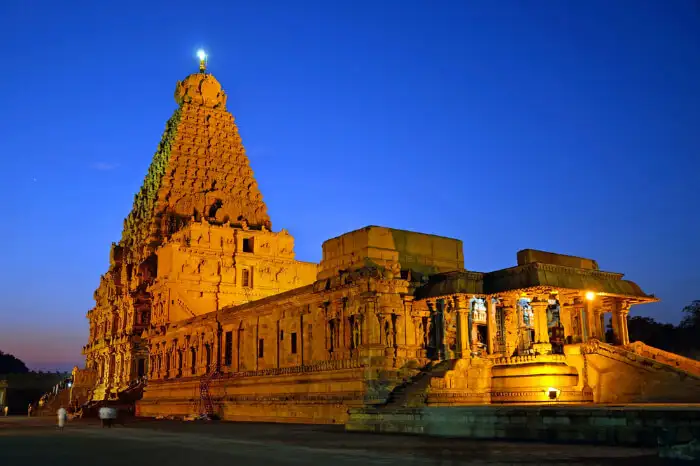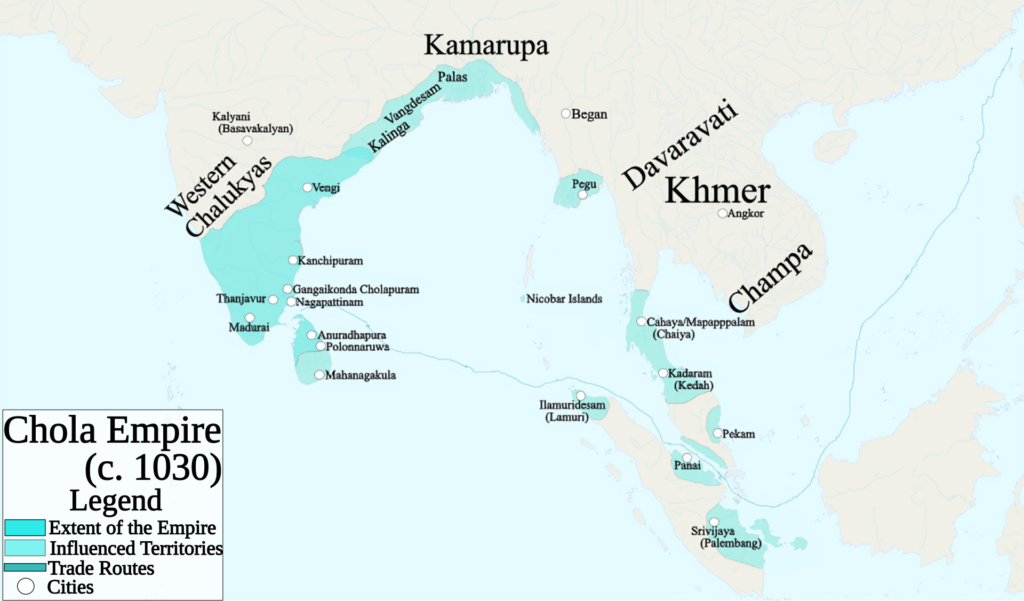Table of Contents

Introduction: Chola Dynasty
The Chola Dynasty was one of the longest and most influential dynasties in Indian history, spanning over several centuries. The dynasty’s legacy can be divided into three major periods: the Early Cholas, the Imperial Cholas, and the Later Cholas. They were known for their military prowess, administrative innovations, and significant contributions to South Indian culture and architecture.
Early Cholas at a Glance
| Category | Details |
|---|---|
| Period | c. 300 BCE – 9th century CE (before the imperial Chola revival). |
| Region | Tamil Nadu, parts of Andhra Pradesh, and Kerala. |
| Capital | Uraiyur (early capital), Kaveripattinam (port city and capital). |
| Prominent Rulers | – Karikala Chola: Most notable early Chola ruler, credited with building the Kallanai (Grand Anicut). – Ellalan: A Chola king who ruled over Sri Lanka and was known for his justice. |
| Major Achievements | – Construction of the Kallanai (Grand Anicut), one of the oldest dams in the world. |
| Economy | Agriculture-based economy; Extensive irrigation systems; Maritime trade with Southeast Asia and the Roman Empire. |
| Decline | Gradual decline due to conflicts with the Cheras and Pandyas. |
Medieval Chola Dynasty at a Glance
Map of Chola Empire

Territorial Extension of Imperial Chola Empire UPSC
- The Cholas conquered large parts of South India, including present day Tamil Nadu, parts of Andhra Pradesh, and Kerala. They extended their rule northward, reaching up to the Ganges River through military expeditions.
- Control of Sri Lanka: Rajaraja Chola I conquered northern Sri Lanka, and his son Rajendra Chola I extended control over the whole island.
- Maritime Power: The Cholas built a strong navy, which helped them dominate the Bay of Bengal and control important trade routes.
- Expansion to Southeast Asia: Rajendra Chola I led expeditions to Southeast Asia, influencing regions like the Maldives, parts of Malaysia, and even the Srivijaya Empire (present-day Indonesia).
| Category | Details |
|---|---|
| Period | 9th century CE (revival under Vijayalaya Chola). |
| Region | Southern India, primarily Tamil Nadu; extended to parts of Karnataka, Andhra Pradesh, Sri Lanka, and Southeast Asia. |
| Capital | Thanjavur (early capital), later Gangaikonda Cholapuram |
| Prominent Rulers | – Vijayalaya Chola: Founder of the Chola dynasty. – Rajaraja Chola I: Expanded the empire significantly, and built the Brihadeeswara Temple. – Rajendra Chola I: Extended the empire to Southeast Asia, and established Gangaikonda Cholapuram as the capital. – Kulothunga Chola I: Consolidated the empire’s territories and administrative systems. |
| Major Achievements | – Dravidian-style temple architecture, notable examples of which include Brihadeeswara Temple, Gangaikonda Cholapuram Temple, and Airavatesvara Temple. – Bronze sculptures of Nataraja. |
| Religion | Predominantly Hinduism, with patronage of Shaivism; also supported Buddhism and Jainism. |
| Language | Tamil (administrative and literary language); Sanskrit used in inscriptions. |
| Art and Architecture | 13th century CE, due to invasions by the Pandyas, and Hoysalas, and internal strife. |
| Administrative System | Well-organized bureaucracy with local self-government in villages (Ur, Sabha). |
| Decline | 13th century CE, due to invasions by the Pandyas, Hoysalas, and internal strife. |
Overview of the Chola Dynasty
- The Chola dynasty was one of the longest-ruling dynasties in world history.
- The earliest references to the Cholas are from inscriptions of Ashoka.
- The main sources of information about the early Cholas are ancient Tamil literature of the Sangam Period.
- There are also brief references to the Chola country and its towns, ports, and economy in the Periplus of the Erythraean Sea.
- Chola Empire is known as a Thalasso cratic empire (a state with primarily maritime realms, an empire at sea, or a seaborne empire).
- The lower reaches of the Kaveri River and its delta are known as Chola Nadu as it was the cultural and political base of the Chola Dynasty.
Early Chola Dynasty (600 BCE–300 CE)
- The Early Cholas were one of the three main kingdoms of Tamilakam.
- Sangam Literature is the main source of information about early Cholas.
- Karikala is recognized as the greatest of the Early Cholas. He made Uraiyur his capital. He is credited for the construction of Kallanai (also known as the Grand Anicut) which is an ancient dam to control the flood of the river Kaveri. The dam is located in Thanjavur district.
- Karikala defeated Pandyan and Cheran king in Battle of Venni.
Imperial Cholas UPSC Notes (Medieval Chola Dynasty)

- Imperial Cholas: The Medieval Cholas were also known as the Imperial Cholas. The empire was known for its vast overseas territories and political influence in Southeast Asia.
- Naval Dominance: The Cholas were known for having the most formidable navy of its time.
- Centralized Government: The Cholas established a centralized form of government with a disciplined bureaucracy, ensuring efficient administration across their empire.
- Temple Architecture: The Cholas were great builders. Notable architectures include the Brihadisvara Temple at Thanjavur, a UNESCO World Heritage Site.
- Artistic Achievements: The Cholas are renowned for their art, especially the bronze statues, which used a lost wax process. This tradition influenced art and architecture in Southeast Asia.
- Decline: By around 1070, the medieval Cholas began losing their overseas territories. Although the later Cholas (1070–1279) continued to rule parts of southern India, the empire declined in the early 13th century due to the rise of the Pandyan dynasty.
Notable Rulers
Vijayalaya
- In the second half of the 9th century, Vijayalaya (c. 850-871 AD) re-established the Chola dynasty of Tanjore.
- The Chola Dynasty was re-established by Vijayalaya in 847 CE. He was a descendant of the Early Cholas.
- His power began in the Urayur region as a feudatory under the Pallavas. Urayur was the capital of the Cholas during the Sangam period.
- He captured Tanjore from a subordinate ally of the Pandyas and set up his capital there.
- Vijayalaya was succeeded by his son Aditya Chola I (871-907 AD), who laid the foundation of the Imperial Chola Empire.
Aditya Chola I
- Conquest of Pallava Kingdom: Aditya Chola I defeated Pallava king Aparajitavarman and captured Tondamandalam.
- Expansion into Pandya and Western Ganga Kingdoms: He occupied parts of the Pandya and Western Ganga kingdoms. Probably the Ganges capital (Talakad) belonged to him.
- Territorial Extent: At the time of his death, the Chola kingdom probably extended from the city of Madras in the north to the Kaveri River in the south.
- Trade Relations: They had trade relations with the Arabs in the west and with the Chinese in the east.
- Conflicts with the Chalukyas: The Medieval Cholas were continuously in conflict with the Chalukyas over the control of Vengi.
Parantaka I (907-953 AD)
- Parantaka succeeded his father Aditya Chola.
- Parantaka invaded the kingdom of Madura captured Madurai (Pandyan capital) and assumed the title Madurain-Konda (Capturer of Madurai). Pandyan king Rajasingha II got help from Sinhala (Ancient Sri Lanka). But the Pandyas and Sinhalese were defeated in the Battle of Velur (Vellore) (915 AD). Chola territory extended up to Kanyakumari in the south.
- Parantaka destroyed the Pallavas and captured territory up to Nellore in the north. Kanchi became one of the capitals of the Chola kingdom.
- The Uthiramerur inscriptions of Parantaka I tell about the evolution of the village administrative system.
Rajaraja I
- He was one of the most powerful kings during his time often regarded as the ‘King of Kings’.
- He ruled vast regions of southern India, northern Sri Lanka, Lakshadweep, and part of the northernmost islands (Thiladhunmadulu Atoll) of the Maldives.
- Rajaraja invaded Sri Lanka defeated Mahinda V and captured the capital Anuradhapura.
- Rajaraja was a follower of Shaivism.
- He built the Brihadishwara temple in Tanjavur in 1010 AD. The temple is also called Rajrajeshwara Temple. It is dedicated to Lord Shiva. The temple is part of the UNESCO World Heritage Site known as the “Great Living Chola Temples”.
- Under his patronage Sailendra king of Srivijaya Empire Vijayattungavarman, built a Chudamani Vihara in Nagapattinam.
- Rajaraja is also known as Tirumurai Kanda Cholan for rediscovering the Tirumurai. Tirumurai is a collection of hymns in praise of Lord Shiva written by various poets (like Appar, Sambandar, Sundarar, etc.) from the 6th to the 11th century CE.
Rajendra I
- Rajendra I reigned between 1014 and 1044 CE.
- He conquered Sri Lanka. Sinhalese king Mahinda V captured and transported to the Chola country in 1017 CE.
- He is known as Gangaikonda Cholan (Bringer of the Ganges), and Kadaram Kondan.
- He assumed the title of “Gangaikondachola” after defeating Malipala of the Pala dynasty in 1022 AD.
- He built his new capital on the bank of river Kaveri which was named Gangaikondacholapuram to commemorate his victory over the Pala Dynasty. The city served as the capital for around 250 years.
- Brihadisvara Temple (dedicated to Shiva) in Gangaikondacholapuram was built in 1035 AD by Rajendra Chola I.

Rajadhiraja
- Rajadhiraja was a skilled military commander and he led many campaigns.
- He died on the battlefield during the Battle of Koppam against the Chalukyas.
Later Chola Dynasty
- The Later Chola period refers to the phase of the Chola Dynasty’s history following its peak of power and influence during the earlier centuries. This period is generally considered to have begun around the 13th century and extended until the eventual decline and absorption of the Chola Empire into other regional powers.
- Raja Raja Chola II: He reigned from around 1146 to 1173 CE and is known for his efforts to revive the Chola Empire after a period of decline.
- Rajadhiraja Chola II: The son of Raja Raja Chola II, he succeeded his father and ruled from approximately 1166 to 1178 CE.
- Kulothunga Chola III: He ascended to the throne around 1178 CE and ruled until 1218 CE.
Chola Dynasty UPSC PSC MCQs
Will be uploaded soon.
